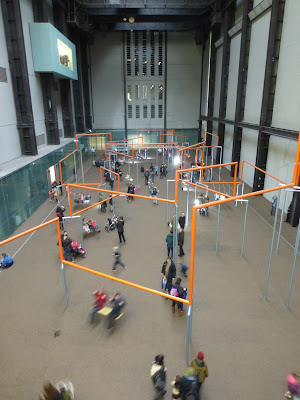A reflection of the Turbine Hall at the Tate Modern art gallery
The pendulum swings slowly from the ceiling with the movement of the Earth. It is suspended above a carpet made in the colours of British banknotes. Designed as a space to contemplate the forces of work in our everyday lives.
Looking down from a central walkway at the Turbine Hall. You get a very good view of the installation from up here.
The installation is called 'One,two,three swing' by Superflex. An orange line of swings weaves its way through the Turbine Hall, this huge place at the heart of Tate Modern, a former power station that once generated energy for the City of London. It then crosses the gallery and emerges in the landscape to the south of the building. The line links production, collaborative action and shared use beyond the gallery into the city's public places and around the world.


Each swing is designed for three people by Danish art collective Superflex. I'm not sure I really understand the thought processes behind the installation but the swings are great fun. I brought my granddaughter here a couple of months ago and we had a lovely time swinging together - until I fell off, but then that just made us laugh even more.

Sharing with James at Weekend Reflection
























































